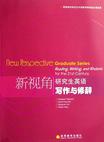新视角研究生英语写作与修辞
出版时间:2007-4 出版社:高等教育出版社 作者:皮尔逊(Herbert Pierson),Sarat Kum 页数:264
前言
随着我国研究生招生规模的不断扩大,研究生教育迅猛发展,教学改革百花齐放,教改成果五彩纷呈。与此同时,研究生英语教学也面临新的挑战。如何顺应新的形势,改革研究生英语教学,提高研究生英语教学质量,是摆在我们面前的、急需解决的问题。为此,高等院校研究生外语教学研究会于2006年3月成立了“研究生英语教学改革”项目组,项目组对我国各研究生培养单位进行大规模调研。 调研结果显示,上世纪八、九十年代出版的《非英语专业硕士/博士学位研究生英语教学大纲(试行)》已经远远不能适应新时期研究生英语教学需要,大纲里的一些教学要求较为陈旧。为此,项目组根据调研结果对《非英语专业硕士/博士学位研究生英语教学大纲(试行)》进行了修订,修订后的大纲名称为《非英语专业硕士/博士学位研究生英语教学基本要求(试行)》。基本要求进一步明确了以下几个方面的内容: 硕士研究生英语教学以培养学生的英语综合应用能力为目标,使他们在今后的工作中能有效地以英语为工具进行本专业的研究和学术交流。由于各校研究生的入学水平、培养目标、师资状况、教学设备等各种情况的差异,硕士研究生英语的教学要求分为基本要求和较高要求两个层次。基本要求是所有硕士研究生毕业时必须达到的标准,较高要求是为那些英语基础较好、对英语需求较高的硕士研究生设置的。硕士研究生的英语教学包括公共/基础英语和专业英语两部分。 基础英语的教学时数一般不少于64学时,安排在两个学期或集中在一个学期进行。基础英语课以一般人文、科技内容为教材,旨在提高学生的综合英语技能、跨文化交际技能、英语学习策略,着重培养学生的语言运用能力。各校可根据基本要求的教学要求和实际情况设置不同课程,如精读课、听说课、翻译课、写作课、读写课、听力课、口语课等。 专业英语的教学时数一般不少于36学时,开课方式视具体情况灵活掌握。可单独设课,也可以与专业课学习或学术论文写作相结合,采取分散或集中的办法。教学组织可以在新生入学到论文答辩前的全过程中进行。专业英语课以本专业的文献为内容,旨在熟练掌握本专业的英语。强调以英语从事本专业的学习、工作和科研的专业语言能力。各校可根据大纲的教学要求和实际情况设置不同课程,如文献导读、论文写作、专业翻译、学术演讲等课程。 各个院校和科研机构可以根据需要和可能,为学生开设实用性强的各类英语选修课程,如英语快速阅读、国际会议英语、英语应用文写作、英语学术论文写作、英语高级听力、英语演讲、英美文化等。各单位还可以根据需求开设以语言、文学、哲学、文化、外国概况等为内容的素质课,以社会交往、国际礼仪等为内容的社交课,以英语国家生存常识为内容的出国预备课等。 博士研究生英语的教学目的以培养学生用英语进行工作和研究的能力为重点,通过英语教学有效地培养学生用英语进行工作沟通和学术交流的能力。博士生英语教学应遵循因材施教、学以致用的基本原则,讲求教学的效率和效果。 在《非英语专业硕士/博士学位研究生英语教学基本要求(试行)》的基础上,我们组织国内具有丰富研究生英语教学经验的专家、学者编写了《新视角研究生英语》系列教材。 《新视角研究生英语》包括基础教程系列和一个开放性的选修课系列教程。基础教程针对研究生阶段的学习特点和教学目标,选择了富有时代气息,能满足研究生的学业、智力和情感需求的语言素材,并辅以多种形式的练习,旨在提高研究生英语综合应用能力。选修课系列教程包括语言应用类、语言文化类教程,旨在提高研究生的英语应用能力和文化素养,为他们在今后的工作中能有效地以英语为工具进行本专业的研究和学术交流打下坚实的基础。
内容概要
《新视角研究生英语》包括基础教程系列和一个开放性的选修课系列教程。基础教程针对研究生阶段的学习特点和教学目标,选择了富有时代气息,能满足研究生的学业、智力和情感需求的语言素材,并辅以多种形式的练习,旨在提高研究生英语综合应用能力。选修课系列教程包括语言应用类、语言文化类教程,旨在提高研究生的英语应用能力和文化素养,为他们在今后的工作中能有效地以英语为工具进行本专业的研究和学术交流打下坚实的基础。《新视角研究生英语写作与修辞》为写作与修辞篇。
书籍目录
IntroductionA Word to TeachersChapter 1 The Writing Process1. The Writing Process2. Why Use the Writing Process?3. Getting Started4. Invention TechniquesChapter 2 The Thesis Statement1. Introduction2. Developing a Thesis Statement3. Constructing a working Thesis Statement4. Placement of Thesis Statement5. Flexibility with Your Thesis StatementChapter 3 Rhetorical Patterns of Writing1. Introduction2. Description and Narration3. Exemplification4. Comparison and Contrast5. Cause and Effect6. Process7. Classification8. Definition9. Argumentation and PersuasionChapter 4 Drafting, Revision, and Grammar1. Drafting2. Revision3. ProofreadingChapter 5 Description1. Introduction2. Three Pillars of Description3. Organizing a Description4. Mastering Writing Techniques5. From Reading to WritingChapter 6 Narration1. Introduction2. The Qualities of Good Narrative Essay3. Mastering Writing Techniques4. From Reading to WritingChapter 7 Exemplification1. Introduction2. The Qualities of Good Examples3. Passages Developed by ExemplificationChapter 8 Comparison and Contrast1. Introduction2. Qualities of Effective Comparison and Contrast3. Two Forms of Organization4. Figurative Comparison5. Mastering Comparison and Contrast Writing6. From Reading to WritingChapter 9 Cause and Effect1. Introduction2. Qualities of Good Cause and Effect Writing3. Organizational Patterns4. Mastering Cause and Effect Organization5. From Reading to WritingChapter 10 Process1. Introduction2. General Steps in Process Writing3. Transitional Words in Process Writing4. Directional Process Writing5. Informational Process Writing6. Seven Suggestions for Writing a Good Process Analysis CompositionChapter 11 Classification and Division1. Introduction2. Three Elements of ClassificationChapter 12 Definition1. Introduction2. The Definition Composition3. Short Definitions or Synonyms4. Denotative and Connotative Definitions5. Concise and Detailed DefinitionsChapter 13 Argumentation and Persuasion1. Introduction2. Evaluating Evidence3. Qualities of Good Argumentation and Persuasion4. Mastering Writing Techniques5. From Reading to WritingAppendix A: Common Chinese Writing ErrorsAppendix B: English Proofreading StrategiesAppendix C: Basic Format of Academic Research Papers
章节摘录
1.In my home town in the American Midwest there used to be a place called the "Y Not Grill" where we hung out as teenagers. We guessed that the name was probably short for "Y Not Come in and Get Food Poisoning." 2.It was a strange place. I was about to say it was awful, but in fact, like most things connected with ones adolescence, it was both wonderful and awful. The food was amazingly bad, the waitresses unfriendly and over the hill, and the cooks always had a cold and sniffed a lot while they cooked. 3.The "Y Not" had a waitress named Shirley, who always worked the night shift and was the most unpleasant person I have ever met. You would ask for, say, a double cheeseburger and fries and she would say "What? You want what?" "A double cheeseburger and fries.Please. If its not too much trouble. And a chocolate malt to drink." Shirley would look at you as if you had asked to borrow her car to drive to Tijuana on the US Mexican border. "You What? A chocolate malt?" you would repeat, trying to keep your voice from wavering.Shirley would stare at you, and then scrawl your order on a pad and shout it out to the chef. 4.I mention this to show that American diners were not always all they were cracked up to be. And yet, as I say, there was something wonderful about them. Even the "Y Not" had its good points. For one thing, it was open all night. For another it was safe and reliable, a little island of light and activity in the darkness of the city. In this respect it was just like that famous Edward Hooper painting of a city diner at night. 5.Hooper did not paint a diner because there was anything exotic about it, but because it was so ordinary. In the 1930s there used to be thousands of diners, along every highway,on every city corner, in every little town. Since the end of the Second World War, diners have almost disappeared. Today there are hardly any real ones. What you get nowadays in America is fake diners of shining stainless steel, where the price of a cheeseburger is twice that of a normal place. 6.And what of the "Y Not Grill"? Its long gone. Im afraid. But even now I remember it well-the steam on the windows, the huddled groups of truckers. Shirley lifting the head of a sleeping customer by the hair to give the counter a wipe with a damp cloth. I miss it a lot, but thank goodness Ill never have to eat that food again.
编辑推荐
Key Features of the Book,The book has been compiled by Foreign and Chinese specialistswho have practiced writing and taught writing to ESL students forover four decades. The book looks at writing as a process, blending this approach withthe traditional, time-proven rhetorical patterns or genres of writing. A wide variety of prose passages, written by well-known American,British, and non-native English writers, have been appropriatelyadapted as resource material not only for writing exercises, butalso as a means for appreciating style and overall improvement ofstudent command of language. The selected and adapted prosepassages range from easy reading of a fifteen hundred word levelto more difficult passages of a six thousand word level. Writing exercises have been presented at three levels: writingtechnique, guided composition, and finally independent writing;thus, enabling students to proceed from carefully controlled writingto free writing in a confident manner. Chapters look at common errors made by ESL students and suggeststrategies to avoid such pitfalls in English writing.Finally, it is eminently suited for use as a writing textbook forgraduate students, advanced undergraduate learners, as well asbeing a writing guidebook for self-study.
图书封面
评论、评分、阅读与下载
用户评论 (总计0条)
推荐图书
- 汉字的正字与正音
- 世界历史九年级下册 多媒体教学……
- 韩式一碗料理
- 忠实的约翰特价(VCD)
- 美人谷
- 阳光家庭365
- 韩式家常菜
- 阳光家庭365
- 勇敢的小裁缝特价
- 多媒体教学资源与教学支持系列 生物学 八年级下册
- 中国历史 七年级上册 多媒体教学资源……
- 多媒体教学资源与教学支持系列 语文 七年级下册
- 光与影的对话-水彩描绘技法
- 语文(四年级下册)
- 我爱泡菜
- 中国土楼
- 阳光家庭365
- 数学(一年级下册)
- 四川名小吃典故与制作
- 英语(新起点)活动手册三年级下册(供一年级起始用)磁带1盘
- 杰克.威尔许的4E领导学
- 大拇指汤姆特价(VCD)
- 多媒体教学资源与教学支持系列 物理 八年级下册
- 特级教师辅导
- Visual Basic程序设计实验指导
